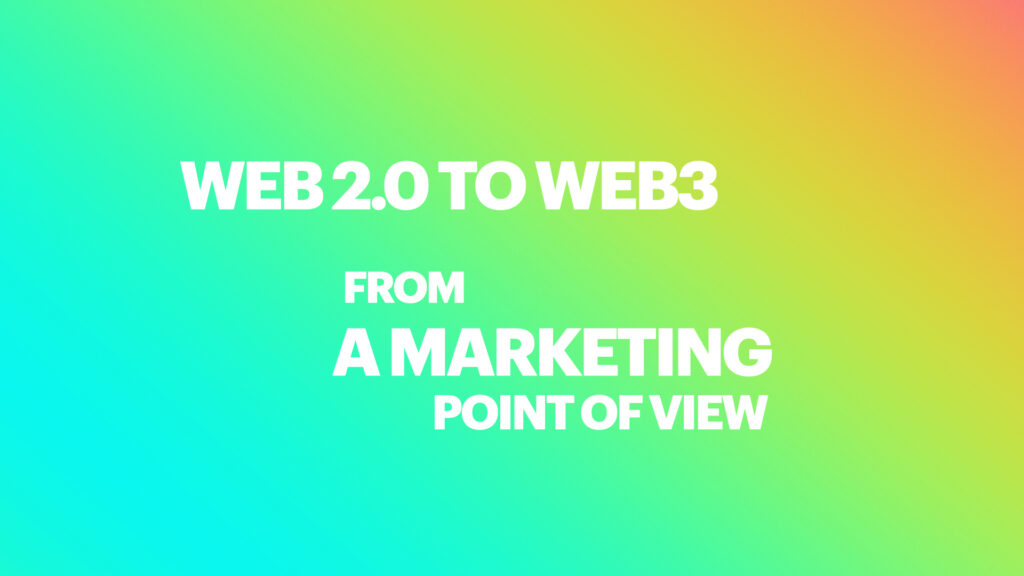Web 2.0 to Web 3 from a Marketing point of view

While I investigate and learn about this whole new internet world, which is Web 3, and the transition from Web 2.0, I wonder about all the new challenges that we, as marketers, will be facing. I really find these changes exciting, because I think all big transformations come with new opportunities to grow.
I want to take a quick look at the evolution of the web in parallel to the evolution of marketing. Understanding the past and how changes have led to the present could help us imagine all these new exciting challenges.
This is what I have understood about the web evolution during the last forty years, by reading Chris Dixon and other authors like Anthony Day.
The first era of the internet (1980-2000) started as a static and non-interactive web led by companies where users could access through the first personal computers.
Computing & storage were also static and power was in the hands of telecom and similar companies, as transparency was in the hands of mass media. These decentralized networks and open protocols also had a lack of capabilities.
So this internet world evolved through centralized platforms gaining a great increase of functionalities and usability. Everything was organized in platforms and interactive websites where users could not only read but also write.
Users multiplied thanks to much greater accessibility based on mobile and cloud infrastructure, during the second era of the internet (2000-today). This era is characterized by an open bar of applications for everybody. For free user-centric services in which the product is indeed the user. At this point, personal data has become the currency to pay for supposedly free easy-to-use products and services.
This new Web 2.0 world has brought with it the concentration of power in a few kingdoms: GAFAs walled gardens. Where there is a lack of transparency leading to easy manipulation of the community, by controlling what the public see and also influencing behavior.
Today, while the Web 3 world is still less friendly for users, it comes with many improvements and new benefits. A decentralized world of communities collaborating and getting rewarded for it in the most equitable way we have known until today. A most open source and transparent space that will accelerate innovation.
This is the era in which power will be more diluted, and borderless networks of large and small entities will coexist. Where storage and computing will be distributed to prevent censorship and keep systems and apps running.
Web 3’s infrastructure laid on blockchain will multiply its potential capacities and, with the help of AI, it will become an intelligent web. Web 3, also known as the semantic web, will be concerned with the meaning instead of the structure of data. Users’ interaction in this intelligent web will not need a third party to exist. So there won’t be intermediaries.
I try to understand this evolution and I wonder how marketing will face this new reality. Having this in mind, I think that it could be helpful to review the evolution of marketing from Marketing 1.0 to the next Marketing 6.0.
I am enthusiastic about Kotler’s point of view about the evolution of Marketing. There is a very interesting interview of him about this particular topic, that you can check here: Forbes’ article by Derek Rucker. I am using it as a reference, trying to synthesize it.
First of all, it is important to notice that the way between Marketing 1.0 and 6.0 is not about transformation, it is about evolution, as each new step includes the previous ones to make the last one complete. It is the growth of a discipline from the first decades of the XX century until today.
So when we talk about Marketing 1.0 we are talking about the marketing that was completely focused on the product or the service the brand was offering. It was worried about a product that was consumer-oriented but just in a functional way. So the communication consisted of a one-way talk about the benefits of the product to the potential target.
In the next step, Marketing 2.0, a step beyond the purely rational was taken, and the brand began to be oriented towards the consumer, taking into account that we are emotional beings. Brands started to create real connections and first “love brands” appeared; those capable of inspiring the consumer. And a new form of communication was born: the dialogue in which the brand wanted to understand how the product made the public feel.
When it turns to Marketing 3.0, brands start to worry not only about consumer feelings but also about social affairs. They need to transcend to be relevant to the consumer. They focus on challenges and issues that involve the whole society. Because this is what matters to the customer, as a member of society. Nowadays we can look at how important it is for Gen Z the purpose of the brands they consume or the companies they work in.
Marketing 4.0 occurred when the digital transformation started, when communication went omnichannel and brands needed more than ever to have a consistent dialogue to earn consumer trust, in a new era when the consumer has the power. At this point, collecting and understanding data is the must-have to earn that trust.
Marketing 5.0 started when after years of collecting data, organizations became capable of really understanding and using it to improve customer experience. The challenges at this point are having a unique and unbiased vision of the individual through an omnichannel environment and using it in a real-time conversation. Brands are working in this way by incorporating AI tools to be able to use collected data to adapt to individual consumer needs, in the best efficient way.
The first steps of Web 3 are now happening and Marketing 6.0 is the necessary step that we, as marketers, will need to take to face new challenges and seize new opportunities. Kotler already points that
“Marketers must move beyond conventional marketing to take a more entrepreneurial mindset to the craft”.
PHILIP KOTLER
My first thoughts are about each marketing point I have reviewed in this post and how the semantic web will evolve each of them:
- The marketing message: semantic web will allow direct and one-to-one messages. No censorship, not influenced or manipulated messages by any centralized platform.
- Brand purpose: Web 3 will enhance real trust because it will be created and built by the community. It will also allow individual contributions to grow the community and brand awareness by organic marketing, a kind of word of mouth.
- Type of communication: it will be real-time, omnichannel, collective, transparent and efficient, and fairly rewarded.
- Data focus and usage: the ownership of private data will be in the hands of individuals. The semantic web will also improve the advanced use of data for community benefit. And profit will be shared among the community instead of being kept for a few huge players.
In the next posts, I will discuss how I am discovering new launch strategies for digital products and services within the Web 3 ecosystem. And I will also wonder how the Web 3 ecosystems will become mainstream.
I am very interested in sharing and commenting on your ideas, opinions, and thoughts about these topics. So can you think of any new Marketing 6.0′ strategy that Kotler mentioned? Please, leave your comment below! 🙂

Leave a Reply
You must be logged in to post a comment.